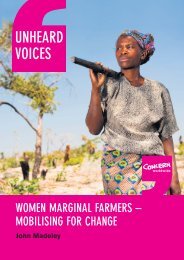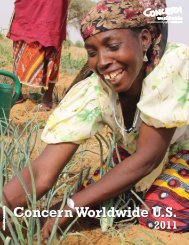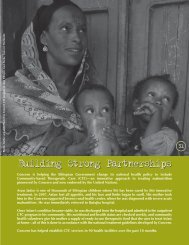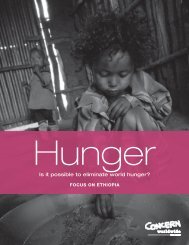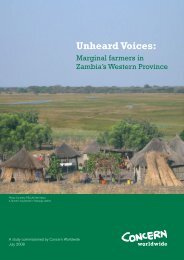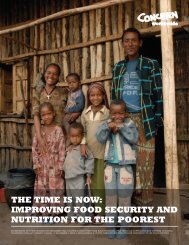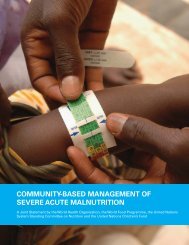education for all children? - Concern Worldwide
education for all children? - Concern Worldwide
education for all children? - Concern Worldwide
You also want an ePaper? Increase the reach of your titles
YUMPU automatically turns print PDFs into web optimized ePapers that Google loves.
EducationHow can a country with limited resourcesprovide <strong>education</strong> to <strong>all</strong> <strong>children</strong>?FOCUS ON SOMALIA<strong>Concern</strong> <strong>Worldwide</strong>
THE RIGHT TO EDUCAT I O NMillions of <strong>children</strong> around the worldcannot read or write their own names.Ap p rox i m at e ly 115 million ch i l d ren never get the ch a n c eto go to primary sch o o l . Millions more are taught byu n t rained and underpaid teach e rs in ove rc rowd e d ,u n h e a l t hy and poorly equipped cl a s s ro o m s, and many d ro pout be<strong>for</strong>e they can read or write. In some communities, itis not unusual to be taught in a class with 70 other students,in a cl a s s room with no electricity, b o o k s, desks or ch a i rs.Can you imagine trying to learn under these conditions??Could you imagine not being able to read this page?WHY IS EDUCATION IMPORTA N T ?E d u c ation is a human right and a key to reducing pove rt yand inequality. It empowe rs people to tra n s fo rm their live sand the societies in wh i ch they live. E d u c ation enabl e speople to re a d , vo t e, e a rn better wage s, c a re <strong>for</strong> theirhealth and have a voice in their commu n i t i e s. It also make speople awa re of their rights and opport u n i t i e s.• Life expectancy rises by as much as 2 years <strong>for</strong> every 1percent increase in literacy.• C h i l d ren of m o t h e rs who have been to school are healthierand more like ly to attend and succeed in sch o o l .• Education is one of the most effective weapons againstHIV/AIDS and other diseases by teaching preventionand treatment methods.GENDER AND EDUCATIONThe majority of <strong>children</strong> not in school are girls — morethan 65 million girls today are not getting an <strong>education</strong>.When families cannot af<strong>for</strong>d to send <strong>all</strong> their <strong>children</strong> toschool, they often choose to send the boys to school,believing that it is a better long-term investment and thegirls can then help with the family chores at home. Earlym a rr i age and preg n a n cy can also prevent girls fro mattending sch o o l , and some countries even have lawst h at prohibit pregnant girls from attending school orreturning to school after their child is born. Safety andsecurity is also a concern <strong>for</strong> some families, and parentsmay be less likely to <strong>all</strong>ow their daughters to travel longdistances to school.ACCESS TO A BASIC EDUCATIONIS A WORLDWIDE PRIORITY• THE UNIVERSAL DECLARATION ON HUMAN RIGHTSrecognizes <strong>education</strong> as a fundamental right. It states that<strong>education</strong> must be free, at least in the elementary stages.• THE INTERNATIONAL COVENANT ON ECONOMIC,SOCIAL AND CULTURAL RIGHTS says that “primary<strong>education</strong> sh<strong>all</strong> be compulsory and available free <strong>for</strong> <strong>all</strong>.”• THE UN CONVENTION ON THE RIGHTS OF THE CHILDobliges governments to “make primary <strong>education</strong> compulsoryand available free <strong>for</strong> <strong>all</strong>.”• At the WORLD EDUCATION FORUM in 2000, 181 countriescommitted to achieve quality basic <strong>education</strong> <strong>for</strong> <strong>all</strong>.• THE UNITED NATIONS MILLENNIUM DEVELOPMENTGOALS agree to work towards securing access to <strong>education</strong><strong>for</strong> <strong>all</strong> <strong>children</strong> by the year 2015.• EDUCATION FOR ALL is a commitment taken on by theinternational community to achieve <strong>education</strong> <strong>for</strong> everycitizen in every society.CHECK IT OUT:Learn more about child labor at: www.hrw.org/<strong>children</strong>/labor.htmRead about gender disparities in <strong>education</strong>: www.girls<strong>education</strong>.org
E D U C ATION A ROUND THE WO R?L DWhy are some countries failing to educate their <strong>children</strong>?Th e re are more than 115 million ch i l d ren around the wo rld who are not in sch o o l. While some countriesa re making notable progre s s, t h e re is still a gre at deal of wo rk that can — and must — be done to ensure that <strong>all</strong> ch i l d ren haveaccess to educat i o n .EDUCATION ISSUES AROUND THE WORLDAlthough the United States has over a 95% elementaryschool enrollment rate, in many rural areas of the country45% of fourth graders read below grade level.In 1993, Bangladeshintroduced the Food <strong>for</strong> EducationProgram in which poor familiesreceive a monthly ration of food iftheir child attends primary school.Although primary schoolenrollment rates <strong>for</strong> boysand girls are equal inCambodia, only 38%of girls complete at leastfour years of school.The governmentof Brazildesigned a programto help eradicatechild labor and reduceschool dropout rates.The program, c<strong>all</strong>edBolsa Escola, payspoor families a monthlystipend to send their<strong>children</strong> to school.About 65% of the<strong>children</strong> in Haitido not attend school;the country’s adultliteracy rate is lessthan 50%.An estimated 860,000 elementaryschool <strong>children</strong> have lost their teachersto AIDS in Sub-Saharan Africa.There was a 23%increase in schoolenrollment when thegovernment of Ugandaabolished school fees.“All <strong>children</strong>, young people and adults have the human right to benefit from an <strong>education</strong> that willmeet their basic learning needs in the best and fullest sense of the term, an <strong>education</strong> that includeslearning to know, to do, to live together, and to be.”- World Education Forum, April 2000CHECK IT OUT:Read about a global school feeding program: www.fas.usda.gov/excredits/gffei.htmlFind out school enrollment rates in the US: www.census.gov/population/www/socdemo/school.html
E D U C ATION IN SOMALIAS o m a l i a s ’ <strong>education</strong> system was suffering fro ms eve re under-funding even befo re the civil wa rb ro ke out in 1991. E d u c ation then became one of the majorcasualties of wa r. The decline of the economy due to the cost ofwar left little money <strong>for</strong> social programs and sch o o l s. I naddition, many schools were completely destroyed during thec ivil wa r, and even today Somalia’s <strong>education</strong> system re m a i n slargely in ruins.Somalia has one of the lowest school enrollment ratesin Africa — 4 out of 5 <strong>children</strong> have no access to school.Without a national Department of Education, it has become theresponsibility of p a rents and community members to prov i d ee d u c ation <strong>for</strong> their fa m i l i e s. E d u c ation is mostly made up ofKoranic schools and schools that are organized and managedby the local community. Many schools don’t have buildings andclasses are often held outdoors or in temporary shelters.C o n c e rn Wo rl dwide is increasing access to and quality of<strong>education</strong> in Somalia by building schools, training teachers, ande n rolling students. Th rough its wo rk , C o n c e rn enables 6,500students to attend school each year.?Who should provide <strong>education</strong> in Somalia?WHY DON’T CHILDREN GO TOS C H O O L ?Th e re are many reasons why ch i l d ren around the wo rl da re not in sch o o l . H e re are some ex a m p l e s :POVERTY: P r i m a ry school is free in the United Stat e s,but at least 100 countries are still ch a rging fees fo rp r i m a ry educat i o n . In many poor countries it can cost am o n t h ’s wages or more to send one child to sch o o l . E ve nthose who are able to attend often cannot affo rd there q u i red unifo rms or books.CHILD LABOR: M a ny ch i l d ren are fo rced to wo rk top rovide additional income <strong>for</strong> their families instead ofgoing to sch o o l . In some cases, ch i l d ren spend their day sat tedious and unhealthy jobs such as making brick s,collecting scrap metal, s ewing footb<strong>all</strong>s or begging inthe stre e t s.HIV/AIDS: In Africa and parts of A s i a , thousands ofs chool teach e rs have died from A I D S. The disease hasalso cre ated many orphans and ch i l d ren often leaves chool to care <strong>for</strong> sick re l at ives or to wo rk to supplementfa m i ly income.LO C AT I O N :For many ch i l d re n , the closest school maybe miles away, fo rcing students to walk <strong>for</strong> hours eachm o rning and afternoon - even during the hottest months.CONFLICT: Wa rs and conflict destroy communities andu p root ch i l d re n . Re f u gee ch i l d ren often do not haveaccess to educat i o n .CULTURE AND TRADITION: Local cultural andt raditional values can also ke ep ch i l d ren from at t e n d i n gs ch o o l . In some tra d i t i o n s, g i rls stay home to help care<strong>for</strong> yo u n ger sibl i n g s. Families may also feel that thes chool curriculum is out of t o u ch with their local culture sand customs.DISABILITY: M a ny countries do not provide any help<strong>for</strong> ch i l d ren with disabilities to attend sch o o l .CHECK IT OUT:Read a report on community schools in Africa: www.aed.org/publications/CommunitySchoolsLiteratureReview.pdfLearn more about how HIV/AIDS affects young people: www.unicef.org/aids/index_youngpeople.html
HOW DO YOU THINK A COUNTRY WITH LIMITEDRESOURCES CAN PROVIDE EDUCATION FORALL CHILDREN?Access to <strong>education</strong> is a basic human right and increases young people’s chances of leading productiveand responsible lives. But providing universal <strong>education</strong> can often be difficult or impossible <strong>for</strong> poor, developing countries.The international community must make a strong commitment to universal <strong>education</strong> in order to make sure that every child — girl andboy — is able to go to school.Here are examples of some of the things being done to make sure <strong>all</strong> <strong>children</strong> haveaccess to an <strong>education</strong>.• INVESTING IN T E ACHER T R A I N I N G• C U R R I C U LUM DEVELO P M E N T• E L I M I NATING SCHOOL FEES• C R E ATING SCHOOL FEEDING PRO G R A M S• P ROVIDING CLASSROOM MAT E R I A L S• ENDING CHILD LABOR• INCREASING GIRLS’ ACCESS TO EDUCAT I O N• P RO M OTING HIV/AIDS EDUCAT I O NWhat do you think is the best way that a country with limited resources can provide<strong>education</strong> <strong>for</strong> <strong>all</strong> <strong>children</strong>?“I wake up every morning at4:30am and walk six kilometersto gather water <strong>for</strong> the family.After school and homework, Iwork until about midnighthelping my aunt sell goods at aroadside market st<strong>all</strong>. It’s not aneasy life but I’m glad that Ihave the opportunity to go toschool.”— Assigno, 12, Togo“ E ven if I could enroll in school <strong>for</strong> fre e, t h e rewould be no money left <strong>for</strong> supplies.”— P i a n a , 1 3 , L e s o t h oThese stories are adapted from: NetAid World Schoolhouse, Campaign <strong>for</strong> Global Education, UNICEF State of the World’s Children
“A few years ago I was sold to a child trafficker. I was sent to Nigeria with other <strong>children</strong> and had tosift sand from gravel in a quarry. It was very hard work and the boss was very mean. But my motherwas able to raise enough money to pay to bring me home to Benin. Now I can go to school and Idon’t ever want to go abroad again.”— Nouroudine, 11, Benin“I go to school three days a week and work therest of the time to help my family. I re<strong>all</strong>y enjoyschool, but my father just got sick and was let gofrom his job. My mother says that I may have togive up school and work full-time to help thefamily.”— Ana, 14, Dominican Republic“I quit school at 13 ye a rs because ofeconomic pro bl e m s. At 15, I tried to comeb a ck , but I wa s n’t accepted any m o re.”— E i ly n , 1 5 , Costa Rica“ We came from Kismaya thre eye a rs ago because there wa sfighting and it was too dange ro u s.H e re it is safer and the parents go tt ogether to open a school <strong>for</strong> thech i l d re n . My mother makes sure thatI go to school eve ry day.”— H a s a n , 13 , S o m a l i a“There are more than 10 girls like me in ourvillage who dropped out of school <strong>for</strong> variousfa m i ly re a s o n s. G i rls are not encouraged toleave and work outside of the home, becausethe local people believe that they will becomec o rrupt and have a difficult time finding ahusband. As a result, girls in their late teensjust stay at home, waiting <strong>for</strong> a matchmakerto find them a husband.”— Wang Xiaoli, 18, China“ For six ye a rs, my school has been in a ra i l ro a dc a r. It is difficult to learn . During the summer it’si m p o s s i ble to stay cool and during the winter it’si m p o s s i ble to stay wa rm… I don’t have gl ove s, s oi t ’s terr i ble to write. After one or two lessons in thec o l d , the teach e rs usu<strong>all</strong>y let us leave.”— I s a , 1 7 , A ze r b a i j a n“I love going to cl a s s e s. Th e re used to be no girls <strong>all</strong>owed in sch o o l . When the school <strong>for</strong> girl sf i rst opened, 50 girls attended on the first day and 83 attended on the second day. N ow I wa n tto be a teacher when I grow up!”—H a z a ra , 9 , Pa k i s t a n
REFERENCES AND RESOURC E SGlobal Campaign <strong>for</strong> Education USw w w. c a m p a i g n fo re d u c at i o n u s a . o r gN e t A i dw w w. n e t a i d . o r gU N I C E Fw w w. u n i c e f. o r gU N E S C Ow w w. u n e s c o. o r g / e d u c at i o nThe Right to Education Pro j e c tw w w. r i g h t - t o - e d u c at i o n . o r gCIA World Fa c t b o o kw w w. o d c i . govPo p u l ation Re fe rence Bure a uw w w. p r b. o r gS t ate of the Wo r l d ’s Children 2004w w w. u n i c e f. o r g / s owc 0 4S chool is the Best Place to Wo rkw w w. s ch o o l i s t h eb e s t p l a c e t owo rk . o r gGlobal Education Dige s tw w w. u i s . u n e s c o. o r g / T E M P L AT E /p d f / ge d / 2 0 0 4 / G E D 2 0 0 4 _ E N . p d fThe World Decl a ration on Education fo rA l l 1 9 9 0World Education Re p o rtUNESCO 2000Final Re p o rt of the World Educat i o nF o rum( D a k a r, Senegal) UNESCO 2000The Dakar Fra m ewo rk <strong>for</strong> ActionE d u c ation <strong>for</strong> All: Meeting our CollectiveCommitments. Adopted by the Wo r l dE d u c ation Foru mCONCERN WORLDWIDE US, INCw w w. c o n c e rnu s a . o rg104 East 40th Stre e t , Suite 903N ew Yo rk , NY 100162 1 2 - 5 5 7 - 8 0 0 0166 East Superior, Suite 502C h i c ago, IL 606113 1 2 - 6 4 2 - 8 4 0 0This publ i c ation is intended to info rm re a d e rs about the issue of e d u c ation and does not necessarily re flect the views of C o n c e rnWo rl dwide U. S. , I n c. or <strong>Concern</strong> Wo rl dwide on this issue. C o n c e rn Wo rl dwide does not off i c i a l ly recommend or endorse any ofthese orga n i z at i o n s.C o n c e rn Wo r l dwide U. S., Inc. is a New Yo rk not-fo r- p rofit corporation exempt from Federal income taxation under section 501(c)(3).C o n c e rn Wo r l dwide U. S., Inc. supports projects carried out in the field by <strong>Concern</strong> Wo r l dw i d e, re g i s t e red in Ireland.P h o t o s : Liam Burke, P ress 22




